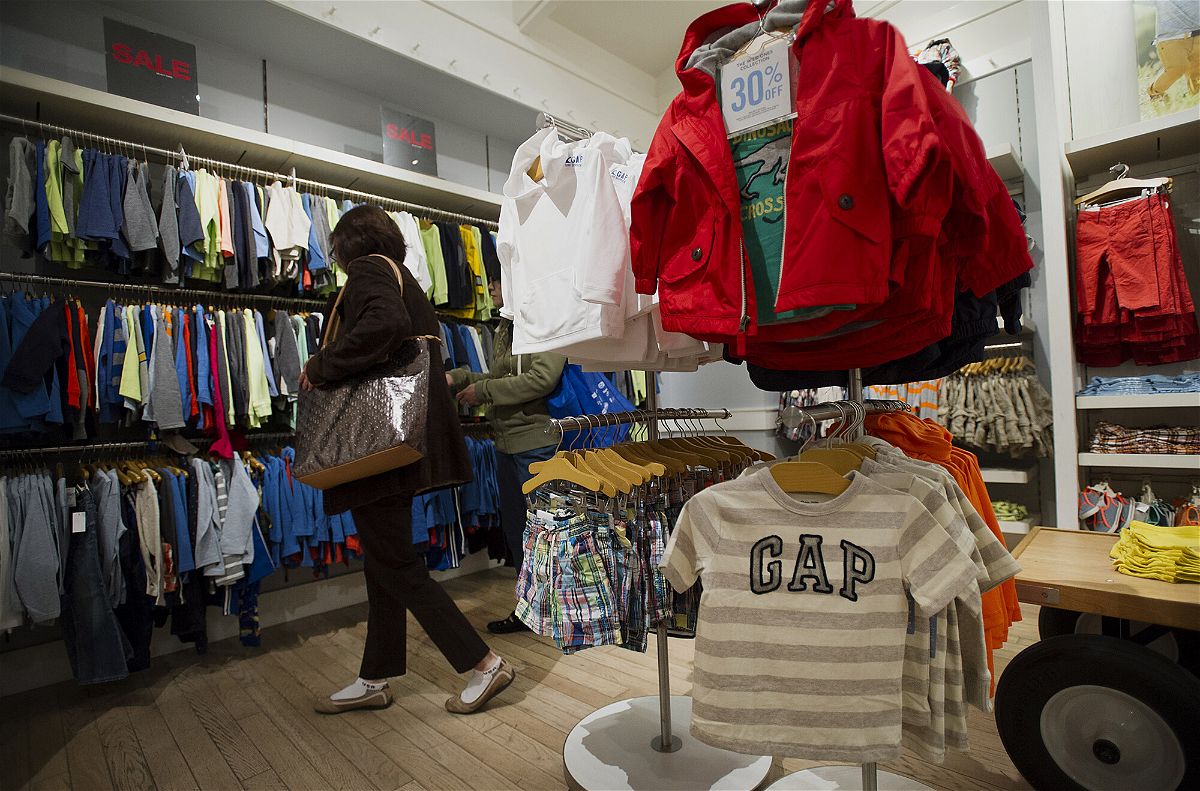Parents are buying fewer baby clothes, a sign of deep financial distress

You know the economy is hurting families when they stop buying baby clothes. A customer here shops for children's clothes at a Gap store in San Francisco
By Parija Kavilanz, CNN Business
Customers are pulling back on spending at Gap and Old Navy — particularly in one specific category that shows just how much families are feeling inflation’s pinch.
In tough times, parents typically skimp on themselves and focus on meeting the needs of their growing children. But Gap and Old Navy said Thursday they’re now seeing less spending on babies’ and kids’ items.
“Spending on kids is one of the last areas most parents cut back on, so softness at Gap and Old Navy suggests that some households are under significant financial strain,” said Neil Saunders, retail industry analyst and managing director of Globaldata.
Because these brands cater to mid-to-low income shoppers, this decline in spending is a very real indicator of how deeply budget-conscious households are feeling the pain of higher prices. They’ve been forced to go to their last resort.
Overall inflation is up 7.7% compared to 2021, even as the latest reading on prices that households pay for necessities and discretionary purchases showed a slight slowdown.
The cutback in kids’ clothing spend at Gap Inc. —which operates its namesake Gap stores, Old Navy, Banana Republic and Athleta divisions under its corporate umbrella — was part of the company’s third-quarter earnings release Thursday.
While overall company sales were up 2% from last year to $4 billion for the quarter ended October 29, the retailer noted that sales growth at both Gap and Old Navy were offset by weaker sales in kids and baby categories.
“Old Navy customers still have a propensity to buy. That being said, it continues to experience softness in spending and shopping frequency from its lowest-income consumers,” Bobby L. Martin, Gap Inc.’s interim CEO, told analysts during the earnings call Thursday.
It’s not just Gap. According to market research firm NPD, purchases of infant and toddler clothing are down this year: From January through October, sales of clothing for infants and toddlers declined by 3% in revenue and 6% in units sold versus the same period last year.
“This is a huge indicator of financial strain,” said Marshal Cohen, chief retail industry analyst with NPD. “One has to look at the total picture. Are families just trading down to less expensive products and stores or is it a pullback in general?”
“The other thing to watch is how long the pullback lasts,” he said. “Parents can go just so long in clothes that are getting a bit small, but not for long. So a quarter slide is one thing — multiple quarters [of decline] send a strong message.”
Turning to resale
As parents purchase fewer new items, they’re turning to resale platforms instead to buy kids clothing and other necessities for less.
Resale platform Mercari said a survey of more than 2,000 parents in March by Globaldata found that 62% said they bought secondhand items for children sometime in the past year. More than a quarter said inflation motivated those purchases, and half of parents surveyed sold a secondhand item in the kids’ and baby items category.
Mercari said parents of kids 2 and under are the most active secondhand shoppers, according to its survey.
“This shift [to reuse] is gaining momentum in 2022 as consumer prices rise amid inflation and ongoing uncertainty,” Mercari US CEO John Lagerling, said in Mercari’s 2022 Reuse Report: Family Edition.
“Americans spent a total of $143 billion on kids and baby items alone in 2021. By 2030, this figure is expected to grow to $182 billion. In our opinion, that’s simply too much,” he said.
Secondhand shopping is becoming a lifeline for budget-strapped households, said Burt Flickinger, retail expert and managing director of retail consultancy Strategic Resource Group.
“Families are relying heavily on credit cards to pay their rent, food and gas bills and everything else. Household wealth is down, while cost of food has surged,” said Flickinger. “If they didn’t plan for it earlier, parents are shopping at resale and taking hand-me-downs from family and friends.”
The-CNN-Wire
™ & © 2022 Cable News Network, Inc., a Warner Bros. Discovery Company. All rights reserved.
